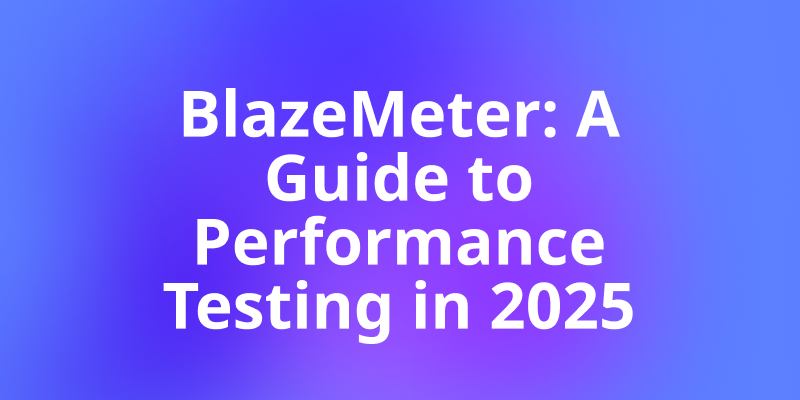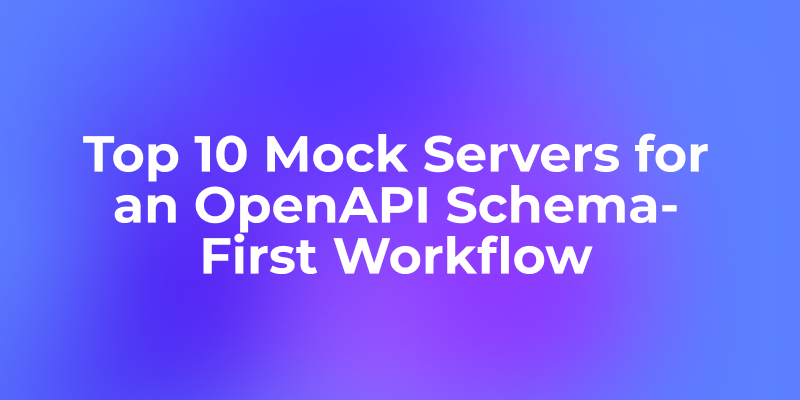If you’ve ever launched a product only to watch your servers collapse under heavy traffic, you already understand why performance testing is essential. In today’s fast-paced world of software development, performance is everything. Whether you’re building a web app, mobile platform, or API-driven service, your application must handle real-world traffic and scale smoothly. Users expect speed—if your site is slow, they'll leave in seconds.
That’s where BlazeMeter comes in. It’s one of the most popular cloud-based platforms for performance and load testing, built to run large-scale stress tests and integrate seamlessly into modern DevOps workflows.
But performance testing isn’t just about flooding your system with virtual users. It’s about understanding how your APIs, apps, and services respond under real-world conditions—and that’s exactly where BlazeMeter shines.
To take things a step further, it’s smart to combine performance testing with API testing. This is where tools like Apidog come into play. With Apidog, you can design, test, and automate your APIs effortlessly. When you pair BlazeMeter’s ability to simulate thousands of concurrent users with Apidog’s streamlined API automation, you get the perfect balance: performance, reliability, and scalability across your entire API ecosystem.
Want an integrated, All-in-One platform for your Developer Team to work together with maximum productivity?
Apidog delivers all your demands, and replaces Postman at a much more affordable price!
What is BlazeMeter?
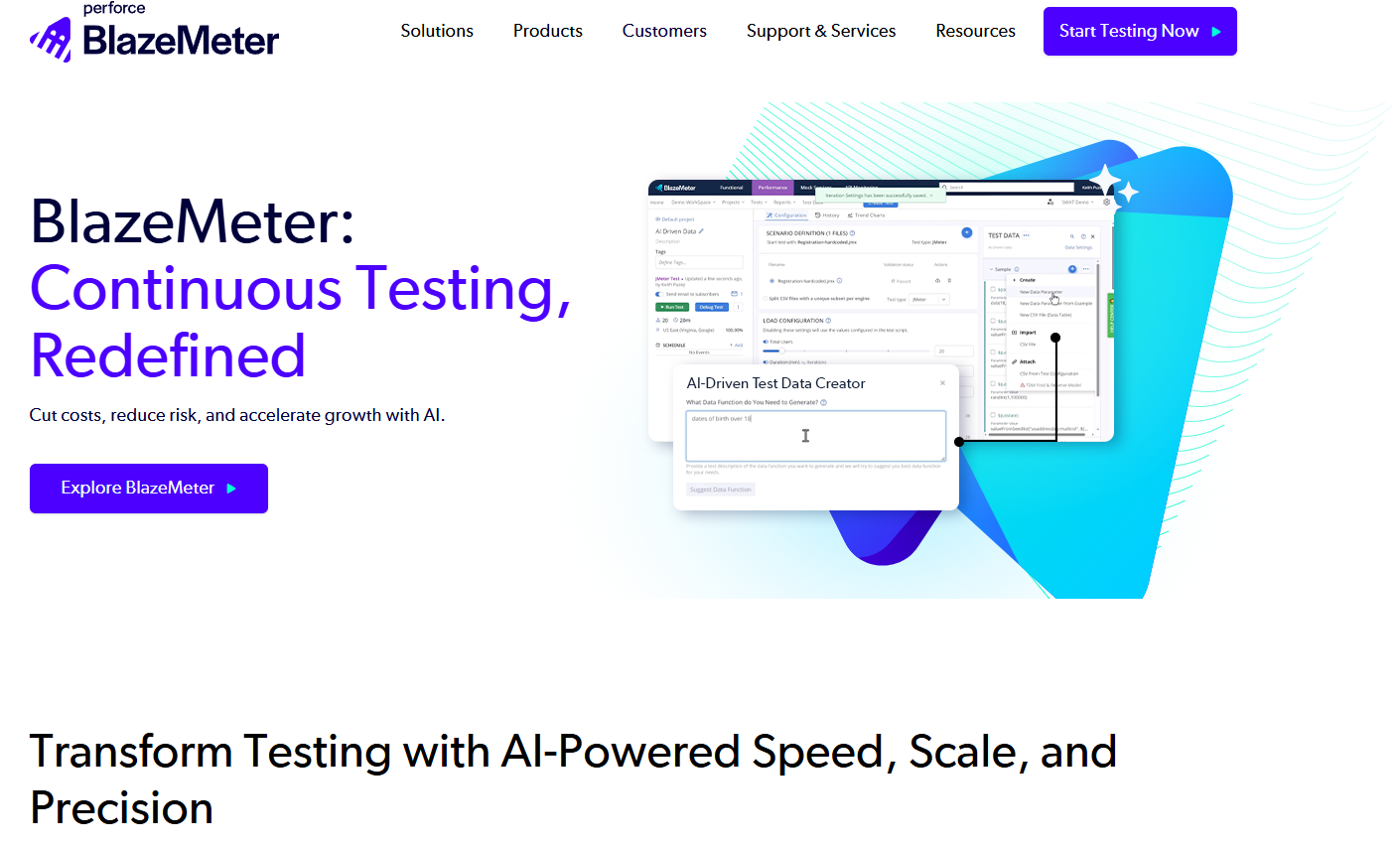
At its core, BlazeMeter is a cloud-based performance and load testing platform. Originally built to extend the popular open-source Apache JMeter, BlazeMeter has since evolved into a full-fledged platform that supports not only performance testing but also API monitoring, functional testing, designed to boost it into an enterprise-ready solution and continuous testing pipelines.
The best part? BlazeMeter is developer-friendly. You don’t need complex hardware setups or huge infrastructure to simulate high loads. With BlazeMeter, It empowers teams to simulate thousands to millions of virtual users interacting concurrently with applications, APIs, and networks giving you realistic insights into throughput, latency, and error rates before your customers do all in the cloud.
In other words, BlazeMeter democratizes enterprise-level load testing.
Why Performance Testing Matters and How BlazeMeter Helps
Performance issues can cripple user experience, cause revenue loss, and damage your brand’s reputation. Think about this:
- 47% of users expect a website to load in under 2 seconds.
- 1-second delay can reduce conversions by 7%.
- A slow site hurts not only your user experience but also your SEO ranking.
With remote work, e-commerce booms, and cloud-native apps dominating the market, performance testing isn’t optional anymore, it’s essential. BlazeMeter makes it easier to ensure that your app won’t collapse under heavy demand.
The challenge is testing scenarios at scale and integrating performance validation tightly into delivery pipelines.
BlazeMeter addresses these challenges by providing:
- Massive scalability: Run load tests that simulate millions of users across multiple geographic regions.
- Realistic traffic generation: Support for multiple protocols, including HTTP, WebSocket, REST APIs, and more.
- Seamless CI/CD integration: Integrate into Jenkins, GitLab, Azure DevOps, and other DevOps tools for continuous performance testing.
- Comprehensive analytics: Detailed dashboards track response times, error rates, bottlenecks, and trends.
- Collaboration: Share results and reports with stakeholders easily.
Key Features of BlazeMeter
BlazeMeter offers a suite of features that make it one of the most versatile testing platforms out there:
- Cloud-Based Load Testing: Eliminate the need for expensive infrastructure by generating load from the cloud, with global agents close to your user base.
- Scriptless and Script-Based Testing Options: For teams that want a no-code option. Begin with scriptless recording for simple test creation and escalate to advanced scripting using JMeter, Selenium, or other tools for complex scenarios.
- API Performance Testing: Test APIs with realistic workloads, including functional validation integrated with performance metrics. Go beyond performance and validate your APIs.
- Multi-Protocol Support: Besides HTTP/HTTPS, BlazeMeter supports protocols like WebSocket, JMS, MQTT, and more, covering varied application architectures, making it easy for existing teams to migrate.
- Test Automation and CI/CD Integration: Embed performance testing into your automated pipelines to detect regressions early and prevent them from reaching production and integrates into CI/CD pipelines for DevOps-ready workflows.
- Distributed Testing: Simultaneously run tests across multiple cloud locations or datacenters for comprehensive coverage.
- Anomaly Detection and Reporting: AI-powered anomaly detection analyzes fluctuating metrics and alerts based on historical trends.
- Team Collaboration: Share reports and insights across teams with ease.
BlazeMeter vs. Other Performance Testing Tools
Traditional load testing often involves significant setup time, limited scalability, and difficulty integrating into agile pipelines. BlazeMeter’s cloud-first approach plus rich automation options streamline this process, offering enterprises the scale and flexibility needed for modern development paces.
When people think of performance testing, JMeter usually comes to mind. While JMeter is powerful, BlazeMeter takes it a step further:
- BlazeMeter vs JMeter: BlazeMeter scales tests in the cloud, while JMeter often requires local setup.
- BlazeMeter vs LoadRunner: BlazeMeter is more modern, cloud-native, and CI/CD friendly.
- BlazeMeter vs Locust: Locust is Python-based and flexible, but BlazeMeter provides better reporting and enterprise features.
Essentially, BlazeMeter blends the power of JMeter with the convenience of the cloud.
How BlazeMeter Works
If you’re new to BlazeMeter, here’s a quick breakdown of how it works:
- Prepare Your Test Scripts: Write or import scripts (e.g., JMeter, Selenium, or Taurus).
- Upload to BlazeMeter: BlazeMeter supports drag-and-drop uploads.
- Configure Your Test: Set parameters like number of users, ramp-up times, and geographic locations.
- Run the Test in the Cloud: BlazeMeter spins up load generators across different regions.
- Analyze Reports: Get real-time dashboards and detailed analytics.
- Optimize Your System: Use the insights to improve performance and scalability.
Real-World Use Cases of BlazeMeter
BlazeMeter isn’t just a theory; it’s used across industries:
- E-commerce Platforms: Ensure checkout processes handle peak-day spikes. Simulate Black Friday-level traffic.
- Banking Apps: Validate APIs and systems against sudden transaction surges. Ensure transactions scale without bottlenecks.
- Streaming Services: Test how servers handle peak demand during big releases. Continuously test streaming performance with concurrent users.
- APIs & Microservices: Validate backend scalability for high-volume requests.
- Healthcare Systems: Comply with uptime and performance SLAs critical for patient care. Stress-test patient portals during emergencies.
How Apidog Complements BlazeMeter in API Testing
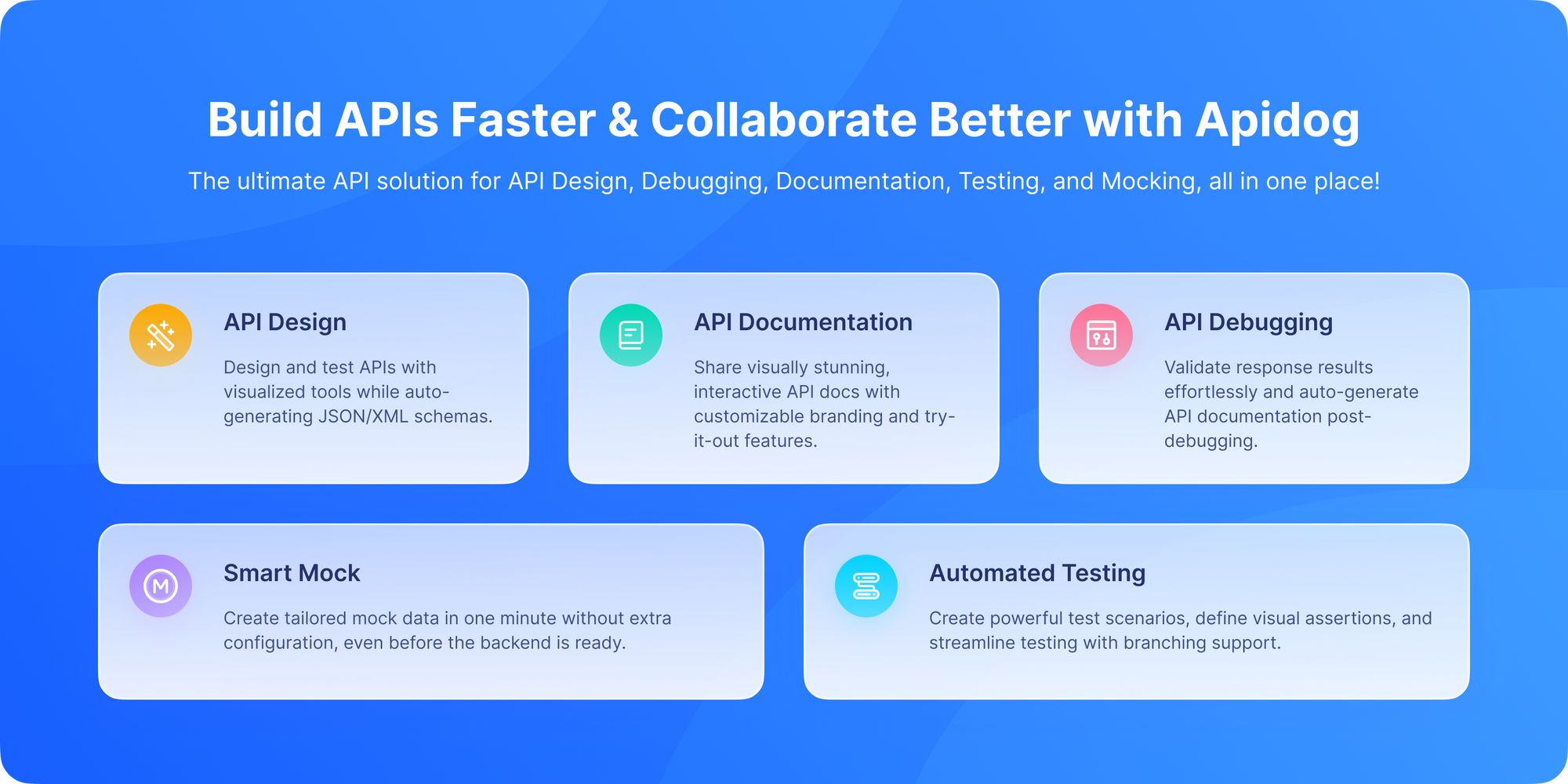
Now here’s where things get interesting. BlazeMeter has built-in API testing capabilities that you can validate functionality, run load tests, and monitor performance. While BlazeMeter focuses heavily on performance, scalability testing and load testing, Apidog provides a holistic API lifecycle management platform that addresses the whole spectrum of API quality:
- API design according to standards.
- Low-code interactive API testing for functional correctness.
- Auto-generated documentation for easy onboarding.
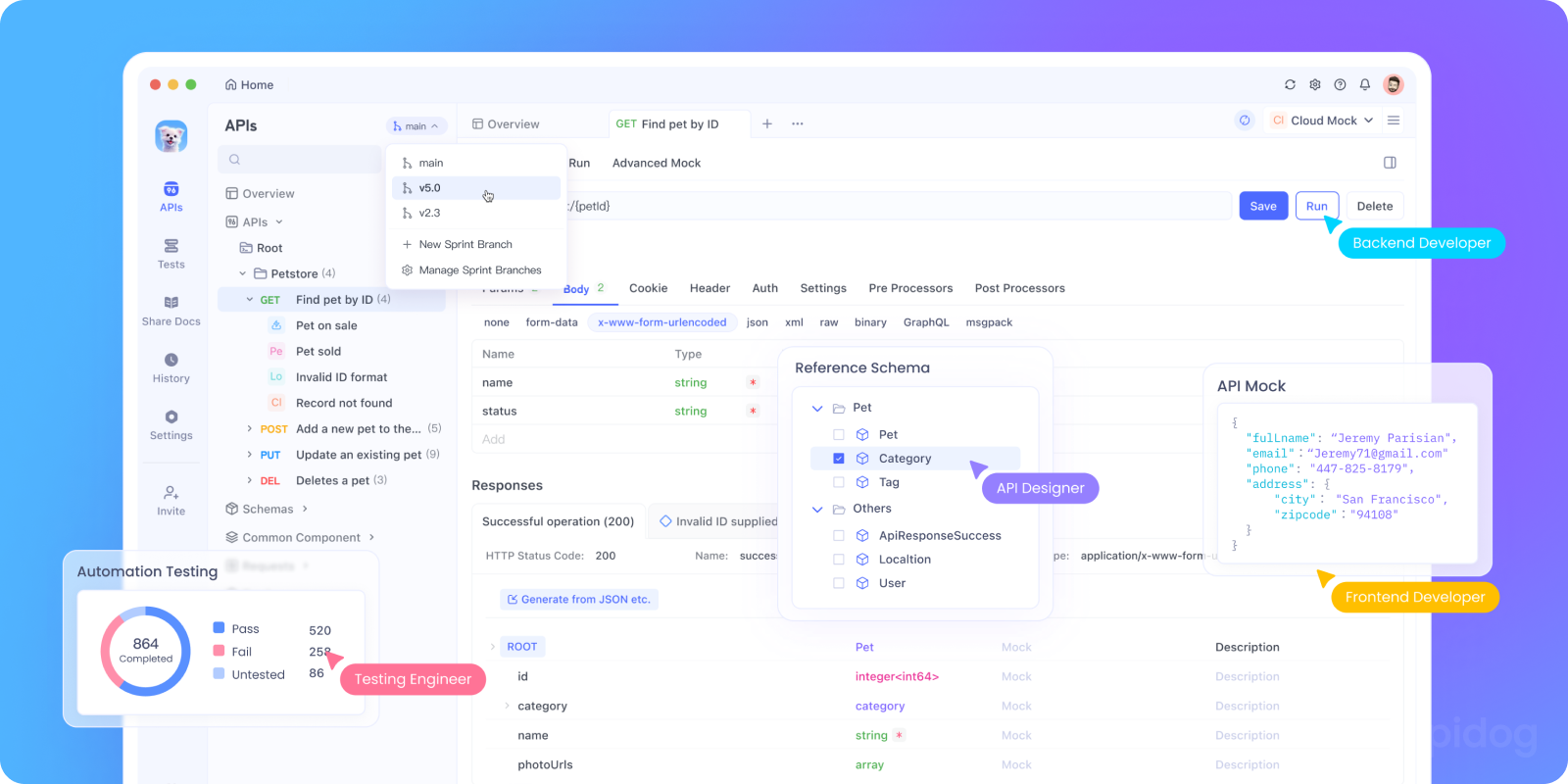
Think of it like this:
- Apidog → API functional testing, schema validation, automation.
- BlazeMeter → API scalability and load testing.
Together, BlazeMeter and Apidog enable teams to ensure both performance and functionality are thoroughly validated throughout the API lifespan, accelerating delivery without compromising quality.
Benefits of Using BlazeMeter
Using BlazeMeter gives teams a lot of advantages:
- Scalability on Demand: Run massive tests without infrastructure headaches.
- Faster Feedback: Real-time dashboards speed up analysis.
- DevOps Friendly: Works well in CI/CD pipelines.
- Cross-Team Collaboration: Developers, QA, and business teams can work together.
- Supports Multiple Tools: JMeter, Selenium, Gatling, and more.
Common Challenges and How to Overcome Them
Even with BlazeMeter, teams may hit roadblocks:
- Script Complexity: JMeter scripts can be tricky. Solution → start with BlazeMeter’s scriptless testing.
- Cost Management: Large-scale tests can be pricey. Solution → optimize test plans and ramp-ups.
- Analysis Overload: Tons of data can overwhelm. Solution → focus on key metrics (response time, error rate, throughput).
Best Practices for Using BlazeMeter in 2025
- Start Small: Don’t jump straight into 1M users. Ramp up gradually.
- Begin with critical user journeys: Test the most business-critical workflows to identify performance bottlenecks.
- Integrate Early: Put BlazeMeter into your CI/CD pipeline. Shift performance testing left to catch issues early.
- Combine with API Testing Tools: Combine load, stress, soak, and spike tests to simulate real-world conditions. Use Apidog for functional validation and BlazeMeter for load testing.
- Test from Multiple Regions: Simulate real-world traffic. Run distributed tests globally to mimic actual user geography.
- Monitor Continuously: Use BlazeMeter’s rich analytics to guide optimization efforts effectively. Performance testing isn’t one-and-done.
Conclusion: BlazeMeter Powers Your Performance Testing Strategy
BlazeMeter remains one of the most powerful and versatile performance testing platforms out there. With the software world moving faster than ever, BlazeMeter equips teams with scalable, automated, and data-rich performance testing capabilities essential for guaranteeing exceptional user experiences.
Whether you’re stress-testing an e-commerce site, validating a mobile app, or ensuring your APIs won’t break under pressure, BlazeMeter delivers. When combined with API lifecycle platforms like Apidog, you get a comprehensive toolkit that not only tests but also designs, documents, and monitors APIs with confidence. But remember performance testing is just one part of the puzzle. To build truly reliable systems, you also need strong API testing workflows.
That’s where Apidog comes in. Together, BlazeMeter and Apidog help you create apps that are both scalable and rock-solid.
So, what are you waiting for? Ready to level up your API testing while running performance checks with BlazeMeter? Download Apidog for free and integrate its low-code API testing capabilities with BlazeMeter’s powerful load testing to build thoroughly tested, high-performing software systems and start building APIs that can handle anything you throw at them today.
